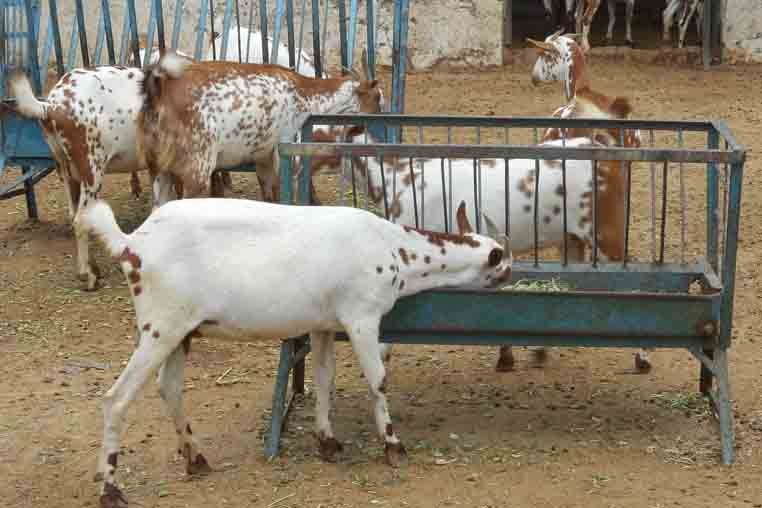Barbari goat farming 100+5 (100 does and 5 bucks)
Stall fed goat farm project report
(To be updated soon)
Barbari goat farming business plan
Stall fed livestock farming is gaining popularity in India due to shrinkage and fragmentation of grazing land . change in eating habit of people is another cause for this increasing demand.. Due to increase in per capita income demand of meat and milk is increasing rapidly . Stall fed livestock farming is an intensive method of livestock farming in which animal remain confined in shed and are not permitted to go outside for grazing. In this system a paddock is generally provided in front of the animal shed where animals are let loose for exercise. Stall fed goat farming is a profitable business and it has several advantages.
Merits of Stall fed goat farming
1-Research proves that overall weight gain is significantly higher in stall fed group in compared to grazing group animals.
2-Occurrence of disease is less in stall fed goat as there is less chance of disease transmission from outside animals.
3-Disease detection is easy under stall fed goat farming as goats remain always under direct supervision of the farmer
4-Record keeping is easy in this system of farming
5-Breeding of does with preferred buck is easy and inbreeding can be easily prevented.
Breed- This project report is prepared on Barbari breed. This breed is a dual purpose breed used for both milk and meat production.
Assumptions
1-Quality disease free young Barbari goats between 12-18 months will be purchased
2- one hector of irrigated land will be utilized for intensive fodder cultivation.
3-Dry fodder will be purchased from local market
3-Manure will be utilized for fodder cultivation
4-In case of death of animals new animal will be inducted from insurance money
5- culled animal will be replaced with new young animals .New animals will be purchased from sell proceeds of culled animals.
6- It is assumed that litter size in first kidding is mostly single. From second year onwards average litter size 1.65
7- Kid born on 1st year will be sold in second year.
8-Entrepreneur /farmer will rear animals with proper care and attention and he/she will undergo training on goat farming before starting goat.
9- Before stating goat farm He /she will undertake market study to find out demand of goat meat and milk in local market
10- Veterinary facility must be available in nearby locality.
Avail Bank loan and subsidy– Subsidy limit under MKUY is 40% of the fixed capital (excluding the cost of the land) subject to a limit of 50.00 lakh for general male category. Subsidy is 50% of the fixed capital limited to 50.00 lakh for SC/ST/Women/Graduates of Agriculture and Allied Disciplines for this type project. Farmer/entrepreneur can apply through GO Sugam Portal. Net annual profit from the project should be more than 2 Lakh for individual & more than one lakh for SHG groups.
| Techno-economic parameters | |
| Breed of Goat | Barbari |
| System of rearing | Intensive |
| No. of breeding Bucks | 5 |
| No. of Does | 100 |
| Age of Does at the time of purchase | 12 months |
| Age of bucks at the time of purchase | 18months |
| Lactation length | 130 days |
| Milk yield per day/doe | 0.8 liter |
| Age at first kidding | 15 months |
| Kidding/ interval (Months) | 8 |
| No of kidding per year | 1.5 |
| Kidding percentage | 90 |
| Average litter size (average of single, twinning, Triplet, quadruplet) | 1.65 |
| Sex ratio | 1:1 |
| Mortality(%) Kids | 5% |
| Weaning period in months | 2 |
| No of kid born in first year | 150 |
| No of kids born from second year onwards | 222 |
| No of kid available for sale in first year | nil |
| No of kid for sale from second year onwards | 210 |
| Saleable age of kids (months) | 9 |
| Expenditure norms | |
| Covered Space requirement sqft .per for Buck | 20 |
| Covered Space requirement sqft. per for doe | 15 |
| Average Space requirement sq ft. per /kid | 5 |
| Cost of construction coved space (Rs. persft) Doe, Bucks ,Kids | 200 |
| Cost of equipment (Rs./adult animal) | 300 |
| Cost of green fodder cultivation (Rs./acre) | 12000 |
| Daily average requirement (KG) of green fodder/adult | 2 |
| Daily average requirement (KG) of green fodder/kid | 1 |
| Average dry fodder requirement /year for all in quintal | 130-170 |
| Cost of dry fodder/kg | 3 |
| Concentrate feed : Adult does/month | 6.75 kg per month |
| Concentrate feed for Bucks /month | 7.5 kg per month |
| Concentrate feed for Kids /month | 3.75 kg |
| Cost of conc. feed (Rs./kg) | 16 |
| Labour (No.) | 1 |
| Labour wages (Rs.per month) | 6000 |
| Insurance (as percentage of the cost of breeding stock) | 4 |
| Veterinary aid (Rs./adult/year) | 100 |
| Income norms : | |
| Sale price of Buckling | 5000 |
| Sale price of Doeling | 4600 |
| Sale price of goat milk/liter in Rs. | 36 |
| Income from manure is not assumed as it is used on the own farm for fodder cultivation. | |
| Sale of Gunny bags (Rs./bag) | 10 |
| Repayment norms: | |
| Repayment period (years) | 5 |
| Grace Period (years) | 1 |
| Interest rate(%) | 12 |

